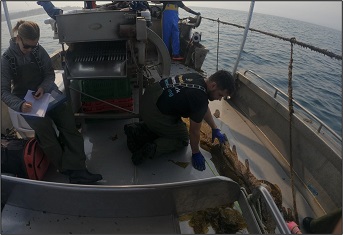Kelp farms being studied to improve coastal water quality

SCCWRP and its partners have completed the initial phases of integrating a pair of Southern California Bight computer models to investigate how offshore kelp farms might be used to reduce the ecological effects of intensifying coastal ocean acidification and hypoxia (OAH).
Researchers are using the two models, which are being coupled in a stepwise fashion, to generate solutions-focused insights about specific potential locations that could be optimal for cultivating kelp farms offshore. Communities in other parts of the world already have started growing kelp offshore as a management strategy for improving coastal water quality, including mitigating OAH conditions.
The model integration work, which kicked off earlier this year, involves coupling a model that predicts how Southern California coastal waters will be impacted by OAH to a second model that explains how kelp farming influences physical and biogeochemical ocean processes. Through the models, researchers can examine the potential of kelp farms in Southern California to remove nutrients and carbon dioxide from the water via the plants’ natural photosynthetic processes.
Excess nutrients and elevated carbon dioxide levels – which come from human activities on land – can exacerbate coastal OAH in Southern California’s coastal ocean, underscoring the need to identify regional management solutions for mitigating these changes to seawater chemistry.
The California Ocean Protection Council, for example, in its 2020-2025 Strategic Plan identified aquaculture, including seaweed farms, as a priority investment – in part, because it’s a potential solution for buffering against coastal acidification.
Over the past few months, researchers have placed kelp farms into the physical-biogeochemical ocean processes model, as well as added kelp effects on ocean physical processes.
Already, the coupled model is being used to investigate how proposed Southern California kelp farms can alter a site’s ocean circulation patterns in ways that cause more nutrient-laden deeper waters to be brought to the site. These nutrients are beneficial in promoting seaweed growth, while the fact that the nutrients are being removed from the water column could change the trajectory of biogeochemical cycling processes that trigger OAH.
SCCWRP and its partners initially are focusing on Santa Monica Bay and the San Pedro shelf, plus Santa Barbara, where pilot kelp farms have already been installed offshore. Each proposed farm site must be evaluated separately, as the potential ecological benefits provided by kelp farming are highly site-dependent.
The two models being coupled together are:
- Southern California Bight OAH model: SCCWRP and its partners have spent nearly a decade developing a state-of-the-art physical-biogeochemical ocean processes model known as ROMS-BEC (Regional Oceanic Model System- Biogeochemical Elemental Cycling) that predicts if and how nutrients introduced via wastewater effluent, stormwater runoff and atmospheric deposition alter pH and dissolved oxygen levels across the Bight. The effort is part of an ongoing West Coast-wide OAH modeling initiative.
- Macroalgal Cultivation Modeling System (MACMODS): A research team led by the University of California, Irvine has spent the past three years developing a model that predicts how kelp farms modify seawater chemistry and ocean circulation patterns. The model explains how kelp farms remove nutrients and carbon dioxide from the water column, trigger more underwater scattering of light due to the kelp canopy, and reduce water flows due to the kelp’s physical structure.
By coupling the models, researchers can examine at a site-specific level how adding a seaweed farm is expected to alter ocean circulation patterns and biogeochemical cycling processes at the site and beyond.
The kelp farming investigation is the second effort by SCCWRP and its partners to leverage the Southern California Bight OAH model to study different facets of coastal ecosystem health. Last year, researchers coupled the OAH model to a coastal algal blooms model to understand when and where production of toxic Pseudo-nitzschia algal blooms is most likely to occur.
Initial results from the kelp farming modeling work are expected to be available in about a year.
For more information, contact Dr. Christina Frieder.
More news related to: Climate Change, Ocean Acidification and Hypoxia, Top News